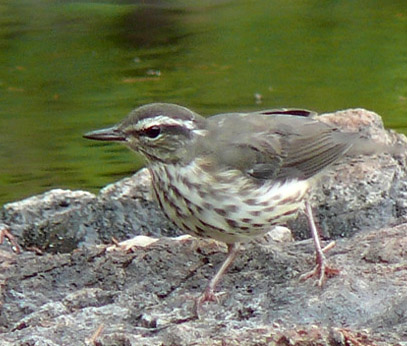by John Shackford

Although it looks like a thrush, the Louisiana Waterthrush (Seiurus motacilla) is actually a warbler.
The Louisiana Waterthrush nests in the eastern U.S. at least as far west as central Oklahoma, while the closely related Northern Waterthrush nests north of us in a wide swath across Canada and into the northern U.S. The 2 species are quite similar in plumage. Some of the easiest, but still subtle, plumage differences are that the Louisiana Waterthrush has a clean white throat, with no spots or streaks, and a white eyebrow (supercilium), while the Northern Waterthrush usually has spots on its throat and an eyebrow tinged yellow.
The Louisiana Waterthrush is a lover of brooks and streams (i.e., where waters flow), while the Northern Waterthrush is usually found about bogs and swamps. This difference appears to hold true even where the ranges of the 2 species overlap in the northeastern U.S. A.C. Bent (1963, Life Histories of North American Wood Warblers, part 2) says that these two waterthrushes have the following behavior traits that help to identify them: “The two species…are much alike in their habits and movements; both of them are walkers and both have the peculiar habit of tilting the tail upward as if a spring holding it down had been suddenly released; both birds spend most of their time on or near the ground walking gracefully along the margins of streams or pools, or even in the shallow water…”
The Louisiana Waterthrush prefers wild places, places that have not been too affected yet by human activity. There has been a pair (I believe, or at least 1) that shows up in the spring of each year in a deep, wooded ravine in our backyard in southern Logan County; this ravine usually has water in it about 1/3 to ½ of the year. With the recent drought the creek dried up and the bird(s), although here earlier, apparently have moved out, perhaps on down “stream” in the ravine until they actually do find water.
Another place in central Oklahoma where I have seen Louisiana Waterthrushes is in a heavily wooded streambed in northeastern Oklahoma City where I have also seen Pileated Woodpeckers on occasion. Along this streambed, with its frequent steep banks extending up from the stream, I have often heard the sharp “chink,”—the callnote—of the Louisiana Waterthrush. Here is another wild area with these wild birds in the middle of town, in an area removed from lawncare. The species is said to nest among the turned up roots of an overtipped tree or elsewhere along steep banks of a stream and the like. Their nest, built on the ground, is usually well concealed, and usually has a short runway of dried leaves that leads into the nest. But even with these tips, I have searched in vain for its nest, although I am confident that a number of times I have been in a nesting territory. This waterthrush usually lays 4-6 whitish eggs that are spotted and blotched with browns and grays.
Tim O’Connell, who teaches biology at Oklahoma State University, has done extensive research on this waterthrush. He has related that nesting birds often have a noticeable increase in the number of droppings on rocks and other areas near the nest, sometimes several droppings within a very small area. Even when he cannot hear a bird calling he has often been able to identify a territory from this whitewash (“splay”). He has wondered, although he admits it would be extremely difficult to prove, if these droppings may warn other waterthrushes that the territory is occupied, or perhaps they are markers for some other reason. In any case Tim’s observations in the vicinity of nests are interesting.
